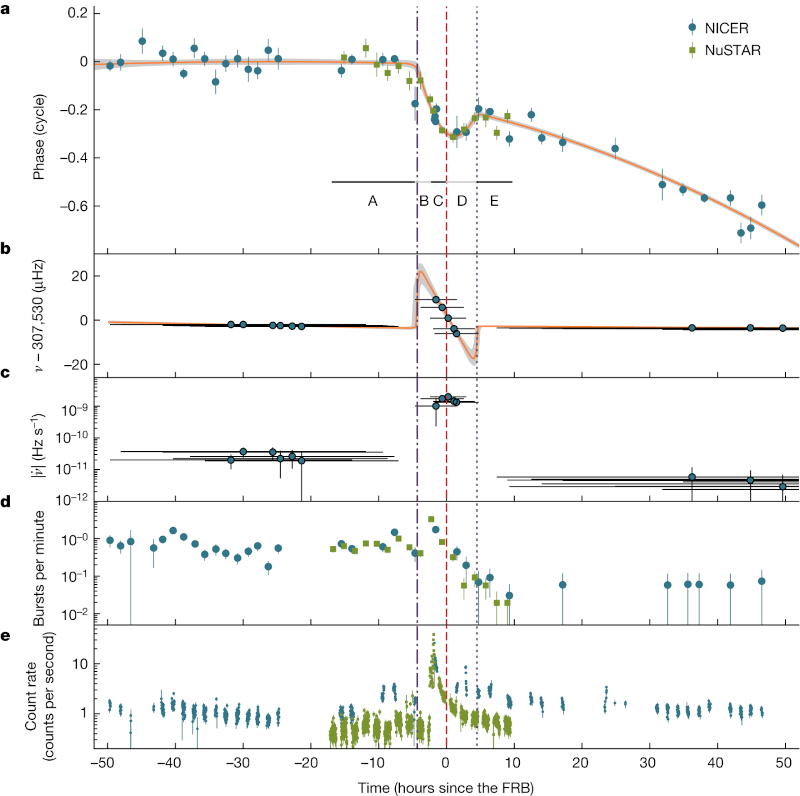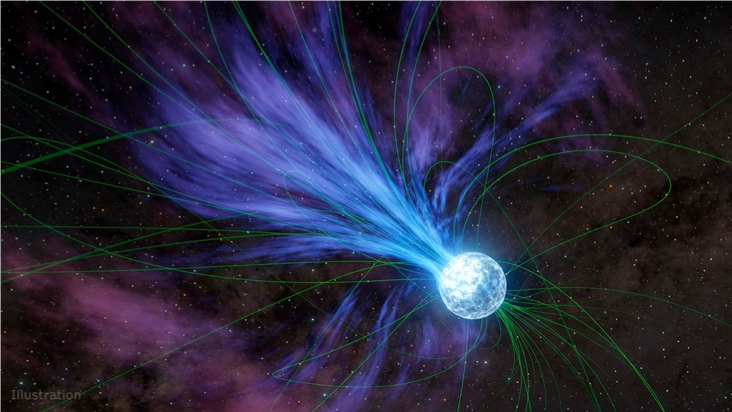NICER / ISS Science Nugget
for February 15, 2024
A Magnetar Tantrum Yields Clues to Enigmatic Radio Signals
Since they were first discovered in 2007, fast radio bursts (FRBs) have been the subject of intense curiosity and research. Over 500 FRBs have been detected, with only a few firmly established to be repeating. Because they are fleeting, lasting only milliseconds, their origin has been very difficult to pinpoint, but until 2020 it was clear that essentially all known FRB sources were extragalactic - i.e., that they reside in distant galaxies, far from our Milky Way. Given these great distances and their short durations, FRBs must be due to extremely energetic phenomena, outshining the total output of our Sun over a year in a fraction of a second. Many phenomena, such as colliding massive objects, have been proposed as possible engines for FRBs, but a long-popular hypothesis is that magnetars - neutron stars with exceptionally powerful magnetic fields - are responsible. In 2020, the magnetar SGR 1935+2154, in our own galaxy, produced an FRB, cementing the connection: at least some FRBs are likely to be produced by distant magnetars. But the specific physical mechanism behind the energetic radio emissions remains a mystery.
In October 2022, SGR 1935 again entered into one of its periodic X-ray-active outburst episodes. NICER and NASA's NuSTAR telescope, which provides complementary high-energy X-ray coverage, began monitoring SGR 1935 intensively. Fortuitously, the magnetar cooperated by producing yet another FRB, detected by two ground-based radio facilities, during the NICER + NuSTAR observing campaign. The fascinating X-ray results were published this week in the prestigious journal Nature, in a paper by C.-P. Hu (National Changhua Univ. of Education, Taiwan) and collaborators, with an accompanying media release. Hu et al. found that the magnetar's spin behavior around the time of the FRB was complex: approximately 4.5 hours before the radio burst, SGR 1935 spun up suddenly in a so-called "glitch", then proceeded to decelerate its rotation more strongly than has ever been seen before in a neutron star, and finally at 4.5 hours after the FRB spun up suddenly again in a second glitch, recovering its original, pre-glitch spin rate. Such glitches are fairly common in young neutron stars, and are thought to occur because of a mismatch in the spin rate of the star's core (a rapidly spinning superfluid) and its crust (which is slowed by having to sweep around the star's powerful magnetic field). Over time, stresses build up and the core rapidly transfers some of its angular momentum to the crust, speeding up its rotation.
But how to explain the strong spin-down episode between the glitches, during which the FRB occurred? A plausible hypothesis is that the first glitch - a 'starquake' - cracked the star's surface, causing a large plume of debris to flow outward into the magnetosphere. The resulting mass loss and increased drag would slow the crust's rotation and provide matter and energy to power the FRB.
This unique result demonstrates the value of high-cadence observations when probing highly dynamic phenomena, a capability recognized by the astrophysics community's current prioritization of "time-domain astronomy".


Left: The timing behavior of magnetar SGR 1935+2154 over 4 days in October 2022, as seen by NICER (blue circles) and NASA's NuSTAR observatory (green squares). Time zero (vertical red dashed line) marks the occurrence of the fast radio burst, while the dashed/dotted black vertical lines denote the times of the two spin-up glitches. Panel (a) shows the evolution of the pulse arrival time (in cycles of the 3.25-second spin period) relative to the pre-glitch timing model; the orange trace depicts the best-fit timing solution. In panel (b), the orange trace (with its 1-sigma uncertainty in gray) shows the timing model's spin frequency evolution, with combined NICER+NuSTAR measurements overplotted as points. Panel (c) plots the spin-down rate (time-derivative of the spin frequency), panel (d) the rate of millisecond-duration bursts detected by the two telescopes, and panel (e) the overall non-bursting X-ray brightness in photons per second. (Figure credit: Hu et al. 2024)
Right: In an ejection that would have caused its rotation to slow, a magnetar is depicted losing material into space in this artist's concept. The magnetar's strong, twisted magnetic field lines (shown in green) can influence the flow of electrically charged material from the object, which is a type of neutron star. (Image and caption credit: NASA/JPL-Caltech)
<< Previous
Main Index
Next >>